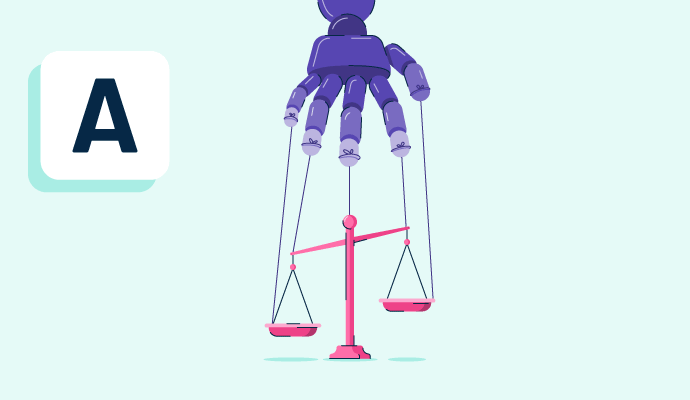Was ist algorithmische Voreingenommenheit?
Algorithmische Voreingenommenheit oder KI-Voreingenommenheit bezieht sich auf die unfairen oder diskriminierenden Ergebnisse, die sich aus der Verwendung von Algorithmen ergeben. Es handelt sich um eine Reihe systematischer und wiederholbarer Fehler in einem Computersystem, die eine Gruppe von Menschen in einer Weise bevorzugen, die nicht mit der Absicht der Algorithmusfunktionen übereinstimmt.
Mit der Verbreitung von künstlicher Intelligenz (KI) und maschinellem Lernen (ML) in verschiedenen Branchen ist algorithmische Voreingenommenheit ein wachsendes Anliegen für alle. Während Algorithmen darauf abzielen, Effizienz zu bringen, sind sie nicht immun gegen Fehler im menschlichen Design. Daher ist es notwendig, die Voreingenommenheiten zu verstehen, die Algorithmen im Laufe der Zeit entwickeln können.
Algorithmische Voreingenommenheiten treten aus vielen Gründen auf - voreingenommene Daten, Designfehler und bewusste oder unbewusste menschliche Vorurteile während der Entwicklungsphase, unter anderem.
KI- & maschinelles Lernen-Operationalisierungssoftware (MLOps) hilft, die potenziellen Risiken von Voreingenommenheit proaktiv zu überwachen und zu mindern. Diese Software hilft, die Konsequenzen zu verhindern, die das Wohlbefinden verschiedener gesellschaftlicher Gruppen stören.
Beispiele für algorithmische Voreingenommenheit
Algorithmische Voreingenommenheit hat viele Formen. Sie kann von rassistischer Voreingenommenheit und Geschlechtervorurteilen bis hin zu Ungleichheit und Altersdiskriminierung reichen. Diese Voreingenommenheiten können jedoch auch unbeabsichtigt sein. Wenn beispielsweise ein Gesichtserkennungsalgorithmus mit einem Datensatz trainiert wird, der nicht inklusiv ist, wird er nicht effektiv für alle Gruppen von Menschen funktionieren. Da diese Voreingenommenheiten unbeabsichtigt sind, sind sie oft schwer zu identifizieren, bevor sie in ein System programmiert wurden.
Hier sind einige weitere Beispiele für algorithmische Voreingenommenheit:
- Rassistische Voreingenommenheit in Gesundheitssystemen: Im Gesundheitswesen können algorithmische Voreingenommenheiten beinhalten, dass die gleiche Qualität medizinischer Einrichtungen bereitgestellt wird, aber von einer Gruppe von Menschen mehr Geld verlangt wird.
- Geschlechtervoreingenommenheit in Einstellungssystemen: Algorithmische Voreingenommenheit kann auch in Einstellungssystemen existieren, in denen ein Geschlecht dem anderen vorgezogen wird. Jede Einstellungsentscheidung, die auf Geschlechtervoreingenommenheit und nicht auf Leistung basiert, ist unfair.
- Rassistische Voreingenommenheit in Strafsystemen: Algorithmen, die die Wahrscheinlichkeit vorhersagen, dass ein Straftäter rückfällig wird, können gegen eine bestimmte Gruppe diskriminieren. Die Vorhersage kann gegen Kriminelle einer bestimmten Rasse voreingenommen sein, was sie für eine längere Strafe haftbar macht.
Arten von algorithmischer Voreingenommenheit
Algorithmische Voreingenommenheit kann viele Formen annehmen und aus verschiedenen Faktoren resultieren. Fünf häufige Arten von Voreingenommenheiten können in einem Algorithmus existieren:
- Datenvoreingenommenheit entsteht, wenn die Daten, die zum Trainieren eines Algorithmus verwendet werden, nicht alle Gruppen von Menschen und Demografien repräsentieren. Dies führt dazu, dass der Algorithmus ungünstige Ergebnisse auf der Grundlage nicht inklusiver Daten produziert. Diese Art von Voreingenommenheit kann in Einstellungs-, Gesundheits- und Strafsystemen existieren.
- Stichprobenverzerrung tritt auf, wenn der Trainingsdatensatz ohne Randomisierung verwendet wird. Sie kann auch auftreten, wenn der Datensatz keine Repräsentation der Bevölkerung ist, für die der Algorithmus bestimmt ist. Dies kann zu ungenauen und inkonsistenten Ergebnissen in einem System führen. Dies kann in einem Bankensystem existieren, in dem ein Algorithmus Kreditzusagen ausschließlich auf der Grundlage von einkommensstarken Gruppen vorhersagt.
- Interaktionsverzerrung existiert, wenn ein System aufgrund der Merkmale oder Demografie der Benutzer unterschiedlich mit ihnen interagiert. Dies führt zu inkonsistenter Behandlung und unfairen Ergebnissen für Menschen in einer bestimmten Gruppe. Diese Art von Voreingenommenheit kann in Gesichtserkennungssystemen gefunden werden, die eine Rasse leichter erkennen als die andere.
- Gruppenzuschreibungsverzerrung tritt auf, wenn Datenteams die Wahrheit über eine Einzelperson auf der Grundlage der Gruppe annehmen, der sie angehören oder nicht angehören könnte. Diese Voreingenommenheit kann in Zulassungssystemen auftreten, die Kandidaten aus bestimmten Bildungshintergründen und Institutionen gegenüber anderen bevorzugen.
- Feedback-Schleifenverzerrung kann auftreten, wenn die voreingenommenen Ergebnisse, die von einem Algorithmus erzeugt werden, als Feedback verwendet werden, um ihn weiter zu verfeinern. Diese Praxis kann die Voreingenommenheiten im Laufe der Zeit verstärken, was zu einer größeren Diskrepanz zwischen verschiedenen Gruppen führt. Wenn beispielsweise ein Algorithmus bestimmte Jobs Männern vorschlägt, könnte er weiter nur Bewerbungen von männlichen Kandidaten berücksichtigen.
Beste Praktiken zur Vermeidung von algorithmischer Voreingenommenheit
Während die Technologiebranche noch einen langen Weg vor sich hat, um Voreingenommenheit in Algorithmen zu beseitigen, gibt es einige bewährte Praktiken, die beachtet werden sollten, um sie zu verhindern.
- Design mit Inklusion: Wenn KI und ML Algorithmen mit Inklusion im Hinterkopf entworfen werden, übernehmen sie keine Voreingenommenheiten. Das Setzen messbarer Ziele für Algorithmen führt zu einer konsistenten Leistung in allen Anwendungsfällen, d.h. für alle Gruppen, unabhängig von Alter, Geschlecht oder Rasse.
- Testen vor und nach der Bereitstellung: Vor der Bereitstellung eines Softwaresystems können gründliche Tests und Bewertungen Voreingenommenheiten identifizieren, die der Algorithmus möglicherweise unbeabsichtigt übernommen hat. Sobald die Bereitstellung abgeschlossen ist, kann eine weitere Testreihe helfen, alles zu identifizieren, was in der ersten Iteration übersehen wurde.
- Verwendung von synthetischen Daten: KI-Algorithmen müssen auf inklusiven Datensätzen trainiert werden, um Diskriminierung zu vermeiden. Synthetische Daten sind die statistische Darstellung realer Datensätze. Algorithmen, die auf synthetischen Daten trainiert werden, sind sicher vor jeglichen übernommenen Voreingenommenheiten realer Daten.
- Fokus auf KI-Erklärbarkeit: KI-Erklärbarkeit ermöglicht es Entwicklern, eine Schicht der Transparenz zu KI-Algorithmen hinzuzufügen. Dies hilft zu verstehen, wie KI Vorhersagen generiert und welche Daten sie verwendet, um diese Entscheidungen zu treffen. Durch den Fokus auf KI-Erklärbarkeit können die erwarteten Auswirkungen und potenziellen Voreingenommenheiten eines Algorithmus identifiziert werden.
Durch die besten Datenwissenschafts- und maschinelles Lernen-Plattformen können Entwickler Daten verbinden, um maschinelle Lernalgorithmen zu erstellen, bereitzustellen und zu überwachen.

Washija Kazim
Washija Kazim is a Sr. Content Marketing Specialist at G2 focused on creating actionable SaaS content for IT management and infrastructure needs. With a professional degree in business administration, she specializes in subjects like business logic, impact analysis, data lifecycle management, and cryptocurrency. In her spare time, she can be found buried nose-deep in a book, lost in her favorite cinematic world, or planning her next trip to the mountains.

